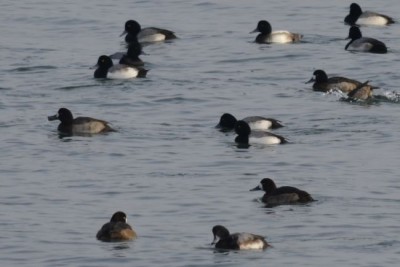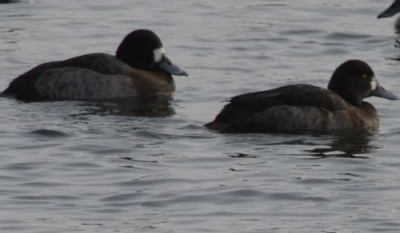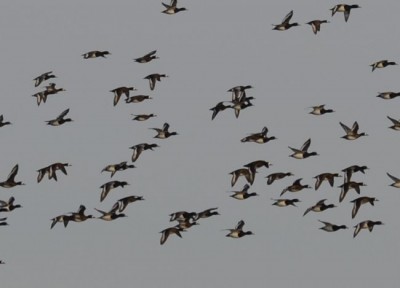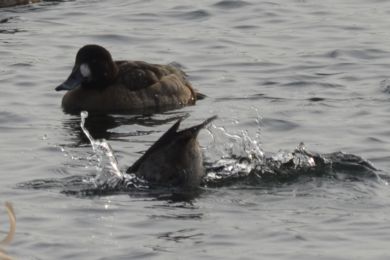 Ok, I said I’d try to count the huge raft of ducks I saw floating in Lake Ontario near the east end of Coronation Park in Oakville last week. It took me a while to get to it, but I did. I opened the photo of about 2/3 of the flock in Photoshop and used grids and pulled guidelines from the rulers to count strips of ducks and then add up the totals. Not including the obvious gulls, or obvious small ducks (Buffleheads), or the 1 Canada Goose (!), I counted over 1440 ducks. Most of the ducks were Greater Scaup.
Ok, I said I’d try to count the huge raft of ducks I saw floating in Lake Ontario near the east end of Coronation Park in Oakville last week. It took me a while to get to it, but I did. I opened the photo of about 2/3 of the flock in Photoshop and used grids and pulled guidelines from the rulers to count strips of ducks and then add up the totals. Not including the obvious gulls, or obvious small ducks (Buffleheads), or the 1 Canada Goose (!), I counted over 1440 ducks. Most of the ducks were Greater Scaup.
I told you it was a huge raft!
Remember, that’s not the whole flock. I only could fit part of it in my photos.
Yes, it did take almost half an hour to count them. But I was very curious and I have no experience with trying to estimate numbers of birds in a flock. I remember Helen Quilliam of the Kingston Field Naturalists could eyeball a raft and come up with an accurate number quite easily. But she was 80 at the time, so she had a few more years practice than I do.
Field Marks for Identifying Greater Scaup in Winter
So how do I know they were mostly Greater Scaup? I asked for confirmation from more experienced birders. Here are a few photos though, to show you the field marks for Greater Scaup.
 If you are close enough to see it, the blue bills are a good field mark for Scaup.
If you are close enough to see it, the blue bills are a good field mark for Scaup.
The males have a black head that goes right down the neck and front in winter. The females have a browner front and head. The females also have a noticeable white patch on their faces near their bills. (The photo is two females.) Both have two-toned backs, although you can see in the first photo that the males and females don’t look the same.
If you notice one diving that’s another field sign. These are not dabbling ducks, who just tip their heads down and keep their tails on top of the water. These are diving ducks. They gather their food to eat while deep underwater. A study by Shannon Badzinski and Scott Petrie concluded that Greater Scaup eat zebra mussels, other gastropods and aquatic vegetation while living on Lake Ontario and Lake Erie.
 In flight, they have a noticeable white streak on the wings.
In flight, they have a noticeable white streak on the wings.
An experienced birder (Hi, Thouc!) says, “The white line on the wing goes almost the whole length of the wing. In Lesser Scaup, the line only goes halfway out.”
Greater Scaup are also somewhat more common in this area in these numbers than Lesser Scaup.
I’ve since seen smaller flocks of Greater Scaup rafting at Lakeside Park in Mississauga, Ontario. But that’s a story for another post.
Further Information
Join In
Do ducks over-winter or stop on migration near you? Did you ever try to estimate the size of a huge flock? Please share your experiences with a comment.

